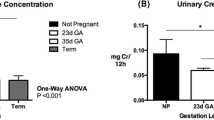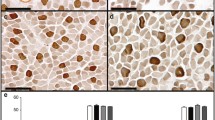Abstract
Recent evidence obtained from a rodent model of birth asphyxia shows that supplementation of the maternal diet with creatine during pregnancy protects the neonate from multi-organ damage. However, the effect of increasing creatine intake on creatine homeostasis and biosynthesis in females, particularly during pregnancy, is unknown. This study assessed the impact of creatine supplementation on creatine homeostasis, body composition, capacity for de novo creatine synthesis and renal excretory function in non-pregnant and pregnant spiny mice. Mid-gestation pregnant and virgin spiny mice were fed normal chow or chow supplemented with 5 % w/w creatine for 18 days. Weight gain, urinary creatine and electrolyte excretion were assessed during supplementation. At post mortem, body composition was assessed by Dual-energy X-ray absorptiometry, or tissues were collected to assess creatine content and mRNA expression of the creatine synthesising enzymes arginine:glycine amidinotransferase (AGAT) and guanidinoacetate methyltransferase (GAMT) and the creatine transporter (CrT1). Protein expression of AGAT and GAMT was also assessed by Western blot. Key findings of this study include no changes in body weight or composition with creatine supplementation; increased urinary creatine excretion in supplemented spiny mice, with increased sodium (P < 0.001) and chloride (P < 0.05) excretion in pregnant dams after 3 days of supplementation; lowered renal AGAT mRNA (P < 0.001) and protein (P < 0.001) expressions, and lowered CrT1 mRNA expression in the kidney (P < 0.01) and brain (P < 0.001). Creatine supplementation had minimal impact on creatine homeostasis in either non-pregnant or pregnant spiny mice. Increasing maternal dietary creatine consumption could be a useful treatment for birth asphyxia.


Similar content being viewed by others
References
Andres RH, Ducray ALD, Schlattner U, Wallimann T, Widmer HR (2008) Functions and effects of creatine in the central nervous system. Brain Res Bull 76:329–343
Bender A, Auer DP, Merl T, Reilmann R, Saemann P, Yassouridis A, Bender J, Weindl A, Dose M, Gasser T (2005) Creatine supplementation lowers brain glutamate levels in Huntington’s disease. J Neurol 252:36–41
Bohnhorst B, Geuting T, Peter CS, Dördelmann M, Wilken B, Poets CF (2004) Randomized, controlled trial of oral creatine supplementation (not effective) for apnea of prematurity. Pediatrics 113:e303–e307
Braissant O, Henry H, Loup M, Eilers B, Bachmann C (2001) Endogenous synthesis and transport of creatine in the rat brain: an in situ hybridization study. Mol Brain Res 86:193–201
Cannata DJ, Ireland Z, Dickinson H, Snow RJ, Russell AP, West JM, Walker DW (2010) Maternal creatine supplementation from mid-pregnancy protects the diaphragm of the newborn spiny mouse from intrapartum hypoxia-induced damage. Pediatr Res 68:393–398
Dafnis E, Sabatini S (1992) The effect of pregnancy on renal function: physiology and pathophysiology. Am J Med Sci 303:184–205
Dechent P, Pouwels P, Wilken B, Hanefeld F, Frahm J (1999) Increase of total creatine in human brain after oral supplementation of creatine-monohydrate. Am J Physiol-Regul Integr Comp Physiol 277:R698–R704
Dickinson H and Walker D (2007) Managing a colony of spiny mice (Acomys cahirinus) for perinatal research. Australian and New Zealand Council for the Care of Animals in Research and Training (ANZCCART) News, 20(1):4–11
Dickinson H, Ireland ZJ, Larosa DA, O’Connell BA, Ellery S, Snow R, Walker DW (2013) Maternal dietary creatine supplementation does not alter the capacity for creatine synthesis in the newborn spiny mouse. Reprod Sci 20:1096–1102
Dickinson H, Bain E, Wilkinson D, Middleton P, Crowther CA, Walker DW (2014a) Creatine for women in pregnancy for neuroprotection of the fetus. The Cochrane Library
Dickinson H, Ellery S, Ireland Z, Larosa D, Snow R, Walker DW (2014b) Creatine supplementation during pregnancy: summary of experimental studies suggesting a treatment to improve fetal and neonatal morbidity and reduce mortality in high-risk human pregnancy. BMC Pregn Childbirth 14:150
Ellery SJ, Ireland Z, Kett MM, Snow R, Walker DW, Dickinson H (2012) Creatine pretreatment prevents birth asphyxia-induced injury of the newborn spiny mouse kidney. Pediatr Res 73:201–208
Ellery SJ, Larosa DA, Kett MM, Della Gatta PA, Snow RJ, Walker DW, Dickinson H (2015) Maternal creatine homeostasis is altered during gestation in the spiny mouse: is this a metabolic adaptation to pregnancy? BMC Preg Childbirth 15:92
Forsberg A, Nilsson E, Werneman J, Bergstrom J, Hultman E (1991) Muscle composition in relation to age and sex. Clin Sci (Lond) 81:249–256
Gualano B, Ferreira DC, Sapienza MT, Seguro AC, Lancha AH Jr (2010) Effect of short-term high-dose creatine supplementation on measured GFR in a young man with a single kidney. Am J Kidney Dis 55:e7–e9
Guerrero ML, Beron J, Spindler B, Groscurth P, Wallimann T, Verrey F (1997) Metabolic support of Na+ pump in apically permeabilized A6 kidney cell epithelia: role of creatine kinase. Am J Physiol Cell Physiol 272:C697–C706
Guthmiller P, van Pilsum J, Boen JR, McGuire DM (1994) Cloning and sequencing of rat kidney l-arginine: glycine amidinotransferase. Studies on the mechanism of regulation by growth hormone and creatine. J Biol Chem 269:17556
Hall JE (2010) Guyton and hall textbook of medical physiology: enhanced e-book, Elsevier Health Sciences
Hanna-El-daher L, Béard E, Henry H, Tenenbaum L, Braissant O (2015) Mild guanidinoacetate increase under partial guanidinoacetate methyltransferase deficiency strongly affects brain cell development. Neurobiol Dis 79:14–27
Hultman E, Soderlund K, Timmons J, Cederblad G, Greenhaff P (1996) Muscle creatine loading in men. J Appl Physiol 81:232–237
Ireland Z, Dickinson H, Snow R, Walker D (2008) Maternal creatine: does it reach the fetus and improve survival after an acute hypoxic episode in the spiny mouse (Acomys cahirinus)? Am J Obstet Gynecol 198:431–436
Ireland Z, Russell A, Wallimann T, Walker D, Snow R (2009) Developmental changes in the expression of creatine synthesizing enzymes and creatine transporter in a precocial rodent, the spiny mouse. BMC Developmental Biology 9(1):39–50
Ireland Z, Castillo-Melendez M, Dickinson H, Snow R, Walker D (2011) A maternal diet supplemented with creatine from mid-pregnancy protects the newborn spiny mouse brain from birth hypoxia. Neuroscience 194:372–379
King BF, Hastings RA (1977) The comparative fine structure of the interhemal membrane of chorioallantoic placentas from six genera of myomorph rodents. Am J Anat 149:165–179
Li H, Thali RF, Smolak C, Gong F, Alzamora R, Wallimann T, Scholz R, Pastor-Soler NRM, Neumann D, Hallows KR (2010) Regulation of the creatine transporter by AMP-activated protein kinase in kidney epithelial cells. Am J Physiol-Renal Physiol 299:F167–F177
Mellanby E (1913) The metabolism of lactating women. Proceedings of the Royal Society of London. Series B, Containing Papers of a Biological Character, 88–109
Mihic S, Macdonald JR, McKenzie S, Tarnopolsky MA (2000) Acute creatine loading increases fat-free mass, but does not affect blood pressure, plasma creatinine, or CK activity in men and women. Med Sci Sports Exerc 32:291–296
Morganti AA, Zervoudakis I, Letcher R, Romney B, von Oeyon P, Papera S, Sealey JE, Laragh JH (1980) Blood pressure, the renin-aldosterone system and sex steroids throughout normal pregnancy. Am J Med 68:97–104
O’Connell B, Moritz K, Walker D, Dickinson H (2013) Sexually dimorphic placental development throughout gestation in the spiny mouse (Acomys cahirinus). Placenta 34:119–126
Ouzounian JG, Elkayam U (2012) Physiologic changes during normal pregnancy and delivery. Cardiol Clin 30:317–329
Perrin DH (2003) Creatine supplementation increases total body water without altering fluid distribution. J Athl Train 38:44–50
Pritchard N, Kalra P (1998) Renal dysfunction accompanying oral creatine supplements. Lancet 352:233–234
Quinn TA, Ratnayake U, Dickinson H, Nguyen T-H, McIntosh M, Castillo-Melendez M, Conley AJ, Walker DW (2013) Ontogeny of the adrenal gland in the spiny mouse, with particular reference to production of the steroids cortisol and dehydroepiandrosterone. Endocrinology 154:1190–1201
Reagan-Shaw S, Nihal M, Ahmad N (2008) Dose translation from animal to human studies revisited. FASEB J 22:659–661
Saunders NR, Dziegielewska KM, Møllgård K, Habgood MD, Wakefield MJ, Lindsay H, Stratzielle N, Ghersi-Egea J-F, Liddelow SA (2015) Influx mechanisms in the embryonic and adult rat choroid plexus: a transcriptome study. Front Neurosci 9
Snow RJ, Murphy RM (2001) Creatine and the creatine transporter: a review. Mol Cell Biochem 224:169–181
Speer O, Neukomm LJ, Murphy RM, Zanolla E, Schlattner U, Henry H, Snow RJ, Wallimann T (2004) Creatine transporters: a reappraisal. Mol Cell Biochem 256:407–424
Thornburg KL, Jacobson S-L, Giraud GD, Morton MJ (2000) Hemodynamic changes in pregnancy. Semin Perinatol 24:11–14
Wallimann T, Tokarska-Schlattner M, Schlattner U (2011) The creatine kinase system and pleiotropic effects of creatine. Amino Acids, pp 1–26
Watt K, Garnham AP, Snow RJ (2004) Skeletal muscle total creatine content and creatine transporter gene expression in vegetarians prior to and following creatine supplementation. Int J Sport Nutr Exerc Metab 14:517
Wyss M, Kaddurah-Daouk R (2000) Creatine and creatinine metabolism. Physiol Rev 80:1107–1213
Acknowledgments
Funding from the National Health and Medical Research Council of Australia (APP1047504) to HD, DWW and RJS, the Cerebral Palsy Alliance to HD and DWW, and the Victorian Government’s Operational Infrastructure Support Program supported this work. HD is an NHMRC Career Development Fellow. SJE and DAL were supported by APA Scholarships during the completion of this study. DWW is supported by Cerebral Palsy Alliance and MMK was supported by a National Heart Foundation of Australia Fellowship at the time of this study.
Author information
Authors and Affiliations
Corresponding author
Ethics declarations
All spiny mouse experiments were approved in advance by Monash University Animal Ethics Committee (MMCA2010/26) and conducted in accordance with the Australian Code of Practice for the Care and Use of Animals for Scientific Purposes. All listed authors have read the final version of this manuscript and provide consent for publication.
Conflict of Interest
The authors declare that they have no conflict of interest.
Additional information
Handling Editor: T. Wallimann and R. Harris.
Rights and permissions
About this article
Cite this article
Ellery, S.J., LaRosa, D.A., Kett, M.M. et al. Dietary creatine supplementation during pregnancy: a study on the effects of creatine supplementation on creatine homeostasis and renal excretory function in spiny mice. Amino Acids 48, 1819–1830 (2016). https://doi.org/10.1007/s00726-015-2150-7
Received:
Accepted:
Published:
Issue Date:
DOI: https://doi.org/10.1007/s00726-015-2150-7




